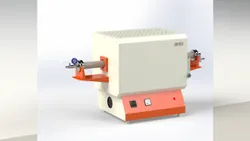Tube Furnace

A tube furnace is an electrical heating device that uses a cylindrical tube to heat materials in a controlled environment. It is Generally used for applications requiring exact temperature control and uniform heating, like material synthesis, heat treatment, and chemical reactions.
Harrier Enterprises specialized in manufacturing of tube furnaces for industrial and commercial needs. We provide superior temperature control, our tube furnaces are test material testing, heat treatment, and research purposes.
Our commitment to quality and innovation, We supply reliable thermal processing solutions that ensure accuracy, durability, and safety. If you need a single-zone or multi-zone tube furnace, we offer customized solutions to suit your specific requirements.
Features of Tube Furnace
- Fast Heating Capability : Tube Furnace achieves high temperatures quickly, reducing processing time and increasing productivity.
- Uniform Temperature Distribution : Tube Furnace ensures consistent heat throughout the chamber for accurate and reliable results.
- Advanced Temperature Control : Tube Furnace equipped with digital PID controllers for precise temperature regulation and monitoring.
- Energy Efficient Design : Tube Furnace minimizes power consumption with efficient insulation and optimized heating elements.
- Strong Construction : Our tube furnace built with high-quality materials for long-lasting performance in demanding environments.
Radiant Tube Furnace
A radiant tube furnace used in radiant tubes, this furnace made of heat-resistant alloys, to heat materials in a controlled environment. These tubes are designed to efficiently transfer heat through radiation, allowing for the heating of materials without directly exposing them to the flames or products of combustion.
Vacuum Tube Furnace
A vacuum tube furnace heats materials inside a sealed tube under vacuum or a controlled atmosphere. This is a type of laboratory furnace and designed for high-temperature processes such as heat treatment, crystal growth, and thin film deposition.
Tube Furnace Working Principle
The working principle of a tube furnace is based on the Joule heating principle, where electric current passes through resistive heating elements (typically made of Kanthal, silicon carbide, or molybdenum disilicide), generating heat. Here are its working principles step by step:
- Heating Elements: The tube furnace contains high-temperature heating coils placed around a cylindrical chamber or tube (made of quartz, alumina, or ceramic).
Heat Transfer: When the heating elements are powered, they generate thermal energy which is transferred to the tube via conduction and radiation. - Sample Placement: The material or sample to be treated is placed inside the central tube, either in a crucible or directly, depending on the application.
- Temperature Control: A digital PID controller monitors and maintains the set temperature using thermocouples for feedback. It adjusts power to the heating elements to ensure stable and accurate heating.
- Atmosphere Control (Optional): Some tube furnaces support inert or reactive gas flow (like nitrogen, argon, or hydrogen) inside the tube to create a controlled environment during processing.
- Cooling Phase: After the heating cycle, the system gradually cools down, either naturally or with the help of cooling fans, depending on the design.





